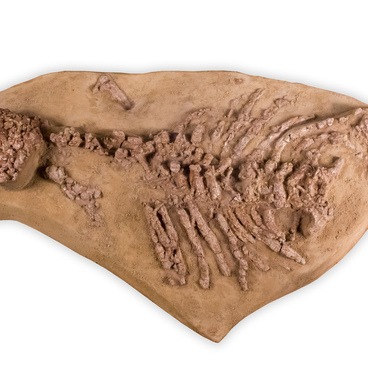The sturgeons are a family of valuable commercial fish species that inhabit almost all of the Northern Hemisphere. Five of their species are found in the lower Volga area: the sterlet inhabits this river permanently; while the starred sturgeon, the bastard sturgeon, the beluga, and the Russian sturgeon only come to spawn. Presently, wild sturgeons are very rare, and their commercial fishing in Russia is allowed only on the Lena River under special licenses.
The Natural History Museum of the Republic of Tatarstan houses a life-size model of the Russian sturgeon in its collection. Nowadays, this rare fish is on the verge of extinction in the wild and is listed in the International Red Book.
The Russian sturgeons inhabit the Caspian, Black, and Azov Seas. They swim to spawn in freshwater rivers: the Volga, Kuban, Terek, Kura, and others. They return to their former habitats after depositing eggs.
Fish of this species are large: their weight ranges from 15 to 25 kilograms. Occasionally there are giant specimens weighing about 80 kilograms and reaching 2.3 meters in length. The Russian sturgeon has a spindle-like body, and its large, elongated head is slightly pointed. This fish has no bones: the whole skeleton consists of cartilage. There are hard spike-like outgrowths called ‘soft rays’ along the body. They also have no scales.
The Russian sturgeon’s body coloration can vary depending on the exact habitat, age, and diet. However, sturgeons with a white belly, grayish-brown back, and similarly colored sides are the most common.
The average lifespan of a sturgeon is about 45 years. They reach reproductive maturity at a late age: males at 8-13 years and females at 8-20 years. These fish swim to spawn only a few times in their lives with intervals of three to four years. Females lay up to 800 eggs, and in two to three days, the fry emerges from them. The Russian sturgeons are able to crossbreed with beluga, starred sturgeon, and sterlet and produce viable offspring. When the fry gets a little older, they swim to sea. During the first months, they feed on plankton. The diet of adults consists of crustaceans, mollusks, and small fish: herring, mullet, sprat, and Danube bleak.
The Natural History Museum of the Republic of Tatarstan houses a life-size model of the Russian sturgeon in its collection. Nowadays, this rare fish is on the verge of extinction in the wild and is listed in the International Red Book.
The Russian sturgeons inhabit the Caspian, Black, and Azov Seas. They swim to spawn in freshwater rivers: the Volga, Kuban, Terek, Kura, and others. They return to their former habitats after depositing eggs.
Fish of this species are large: their weight ranges from 15 to 25 kilograms. Occasionally there are giant specimens weighing about 80 kilograms and reaching 2.3 meters in length. The Russian sturgeon has a spindle-like body, and its large, elongated head is slightly pointed. This fish has no bones: the whole skeleton consists of cartilage. There are hard spike-like outgrowths called ‘soft rays’ along the body. They also have no scales.
The Russian sturgeon’s body coloration can vary depending on the exact habitat, age, and diet. However, sturgeons with a white belly, grayish-brown back, and similarly colored sides are the most common.
The average lifespan of a sturgeon is about 45 years. They reach reproductive maturity at a late age: males at 8-13 years and females at 8-20 years. These fish swim to spawn only a few times in their lives with intervals of three to four years. Females lay up to 800 eggs, and in two to three days, the fry emerges from them. The Russian sturgeons are able to crossbreed with beluga, starred sturgeon, and sterlet and produce viable offspring. When the fry gets a little older, they swim to sea. During the first months, they feed on plankton. The diet of adults consists of crustaceans, mollusks, and small fish: herring, mullet, sprat, and Danube bleak.



